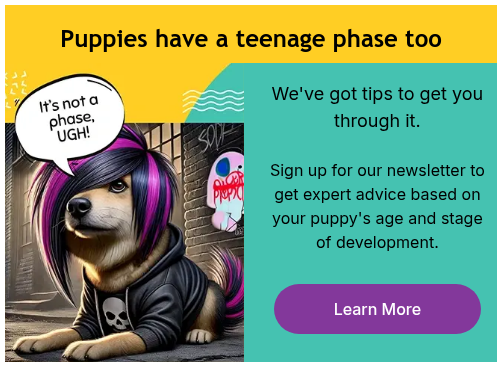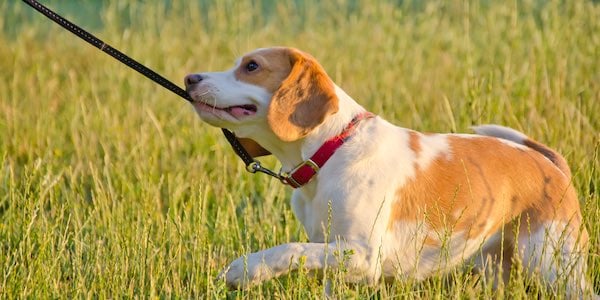 As your puppy grows into adolescence, your once cute and eager-to-please furball often becomes challenging to handle. This teenage stage is a critical period in a dog's life where significant changes occur both mentally and physically.
As your puppy grows into adolescence, your once cute and eager-to-please furball often becomes challenging to handle. This teenage stage is a critical period in a dog's life where significant changes occur both mentally and physically.
Understanding what to expect during your dog's teen years is crucial to be able to navigate this tumultuous phase and maintain a healthy and harmonious relationship with your dog.
Adolescence begins for your puppy when they are around 6 months old and typically lasts until 18 months to 2 years old. In some breeds, such as livestock guardian dogs, they don't reach behavioral maturity until around 3 to 4 years old.
Many dogs are relinquished to shelters due to the frustrating behaviors that are completely normal during this time of life. Understanding the challenges and investing time and effort into training and behavior management during adolescence can significantly reduce the number of dogs ending up in shelters or being euthanized.
Table of Contents
Brain Development in Adolescent Dogs
Big Feelings
Your dog's amygdala is in charge of passing on emotional associations to other parts of the brain, but during adolescence, the inhibitory neurons for the amygdala aren't fully developed. This means that your dog has BIG BIG feelings. Good feelings, bad feelings, fear, excitement, you name it, they feel it to the maximum. And there isn't a lot of rational thought happening to mitigate those emotions because the prefrontal cortex is not fully developed yet.
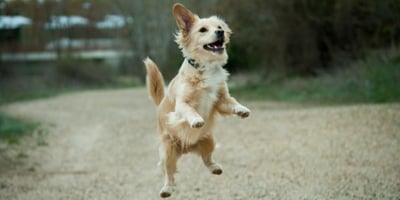 Impulsivity
Impulsivity
Your dog's prefrontal cortex, responsible for cognitive functions such as decision-making, impulse control, and emotional regulation, undergoes significant remodeling during adolescence. These changes can result in impulsive behavior.
Your dog will experience lots of emotions (thanks to those inhibitory neurons missing from the amygdala) — but doesn't have quite the impulse control needed to make the best choices in those moments.
Fear Periods in Adolescent Dogs
Fear periods are specific developmental stages in a young dog's life when they may suddenly display heightened fear or anxiety towards certain things in the environment that didn't previously bother them. These fear periods can happen because your dog's brain is still developing, such as the regions responsible for processing emotions and fear responses.
Adolescent dogs become more sensitive to new or unfamiliar stimuli as part of their normal behavioral development. This heightened sensitivity can lead to a sudden fear or anxiety response when they encounter something they haven't experienced before, even if they were previously confident in similar situations. This is because their brain is processing and evaluating these new experiences differently. As they start to feel the desire to be more "independent," their brain adds extra guardrails to increase self-preservation behavior.
It's important to note that not all dogs will go through fear periods, or if they do, the timing and severity can vary widely. Some dogs may experience multiple fear periods, while others may have none at all. It's highly dependent on the individual dog's genetics, early socialization experiences, and environment.
Physical Development of Adolescent Dogs
Sexual Maturity
Hormonal changes during adolescence can increase sexual behaviors in both intact and neutered dogs. Increased mounting and humping, scent marking (in both males and females), or roaming tendencies can occur as a result. Some dogs can exhibit unusual playfulness with other dogs, while others may become more intolerant of play – even to the point of exhibiting aggression.
When a dog hits sexual maturity, they can be more jumpy and anxious as they adjust to the hormonal shifts. Proper management, spaying or neutering, and providing guidance and redirection can help mitigate these behaviors.
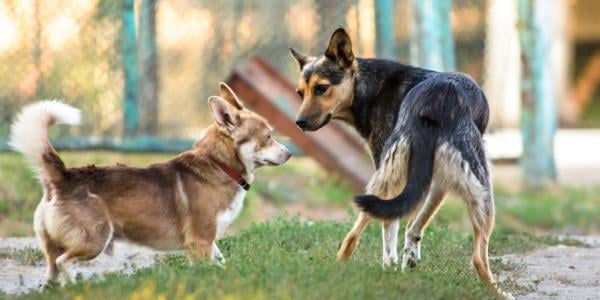
Change in Growth Speed
Most of your pup’s rapid growth occurred between three and five months of age. Typically, by 5 months of age, large breed dogs have reached half their adult weight, and they have developed the skeletal structure they need as an adult.
Your pup’s growth will start slowing down around 6 months of age. By this age, small breed dogs are just about done physically growing, but they will continue to fill out for the next several months. Medium and large breed dogs still have some growing to do, but at a much slower rate.
Predispositions to Medical Issues
Predisposed medical issues, such as hip dysplasia, elbow dysplasia, portosystemic shunts, or allergies, can become evident around this age. Knowing what medical issues your dog’s breed is predisposed to is critical. Being able to recognize early signs and having them evaluated by a veterinarian routinely for these issues can help lessen discomfort as well as improve the long-term outcome.
For dog breeds predisposed to heart disease, such as dilated cardiomyopathy or mitral valve disease, have them screened yearly starting at one year old.
Training Challenges with Teenage Dogs
Pushing Buttons
Adolescence is a time when dogs refine their social skills and, consequently, may display increased independence and a desire for autonomy. This newfound independence, combined with increased exploration and natural curiosity, can manifest as testing boundaries and rebellion during training sessions.
Your teenage dog will find it very fun to find what annoys you the most (and what gets them attention, even if it's "negative" attention) and then do it over and over again. They also tend to do this with other dogs they live with or meet for playdates. Don't take it personally. In fact, by overreacting to these moments by giving your dog attention, you're inadvertently reinforcing the behavior.
Don't let on that your dog is succeeding in pushing your buttons. Instead, calmly interrupt and redirect the behavior. The less of a fuss you make about their shenanigans, the more likely they'll be to give them up and try other ways to get your attention. Focus on teaching them appropriate options for getting your attention or other rewards, and they'll soon get the idea.
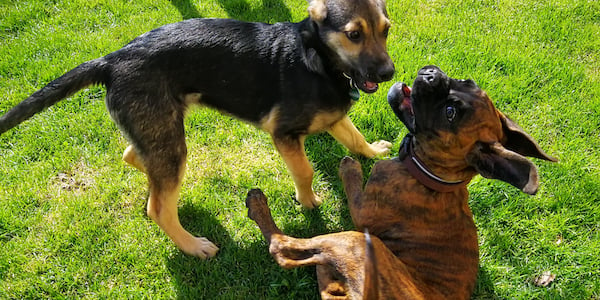
Increased Distractibility
Adolescence is known for heightened distractibility due to hormonal fluctuations and a desire to explore the world. Incorporating training exercises in low-distraction environments, gradually increasing distractions, and using high-value rewards can help maintain focus during this period.
Don't expect too much from your dog too soon. Set them up for success by making sure the environment matches their ability and that you have value in your dog's eyes. The more fun, exciting, and wacky you are, the better! And seriously, don't forget to use high-value treats. Kibble isn't going to cut it around distractions with a teenage dog.
For safety reasons, keep your teenage dog on leash when outside of your home or securely fenced area. Use a long leash when practicing skills that require more distance, such as reliable recall or stay.
Regression of Training Skills
Dogs may experience regression in previously learned behaviors as their priorities shift temporarily during adolescence. This is totally normal and not your fault. A recent study shows that teenage dogs tend to respond better to other people than their owners. Even complete strangers! So the fact that your dog is a rockstar at training class when the trainer uses them as a demo dog, but won't do anything for you — that's not your imagination.
 Ways to Manage a Teenage Dog Without Losing Your Mind
Ways to Manage a Teenage Dog Without Losing Your Mind
Increase Mental Enrichment
You may have heard the saying, "A tired dog is a good dog." Well ... this isn't always true, especially for adolescent dogs. Yes, a dog needs physical exercise, and many dogs are not getting enough. But I often see well-intentioned clients over-exercising their young dog, which tends to backfire. Now you have a super tired but overstimulated dog, who is also getting more conditioned to needing a higher amount of exercise.
Instead of overdoing it with physical exercise to tire out your teenage dog, focus on increasing their mental enrichment. This helps burn excess energy but also can help your dog calm down and decompress. There are 3 easy ways to calm down a hyper teenage dog: licking, chewing, and sniffing. These activities are naturally calming because of their repetitive nature.
Make every mealtime a puzzle to work out your dog's brain and satisfy their instinct to forage and work for food. Check out how to choose the best puzzle feeder for your dog here.
For more, check out lots of dog enrichment tips, toys, and DIY options here.
Manage the Environment
Set your teenage dog up for success! If they are struggling with over excitability with visitors, then don't allow them to rush guests at the door. Keep them on leash or behind a gate, or completely separated in another room with a stuffed dog puzzle or licking mat. Managing the environment is an often-overlooked but very important part of training and behavior modification.
Think about ways you can prevent your dog from engaging in unwanted behaviors in the first place, simply by changing the space or your handling habits. This might mean not taking your dog to the cafe or brewery like you want to or not letting them play at the dog park. While this might be disappointing for you, it's crucial to not let them practice undesired or potentially dangerous behaviors that can turn into lifelong issues.
Meet Your Dog's Needs
Your dog has instinctual needs, based on just being a dog in general, but also can be specific to their breed or breed mix. Engaging in breed-appropriate activities, like retrieving for retrievers or scent work for hounds, can be both physically and mentally stimulating while greatly satisfying for your dog.
Beyond burning excess energy, providing an outlet for your teenage dog's natural behaviors means that they won't put their talents to use inappropriately. Herding breeds may have a strong instinct to chase and control movement (and children are great substitutes for sheep), so offering them activities like agility training or herding trials can help satisfy these natural inclinations. In contrast, spaniels, water dogs, and retrievers thrive in activities that involve retrieving or water-based exercises. Terriers often enjoy digging, so providing a designated digging area can prevent unwanted digging in your yard or garden.
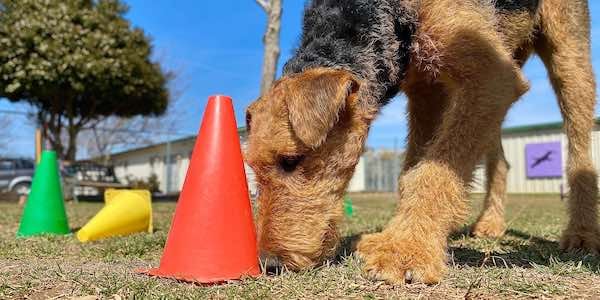
Understanding your dog's breed-specific traits allows you to tailor their daily routine, ensuring they receive the mental and physical stimulation they need to thrive during their teenage years and beyond. By striking a balance between their universal needs as dogs and their breed-specific instincts, you can help your teenage dog grow into a happy, well-adjusted adult.
Take this quiz to get breed-specific suggestions for your dog's enrichment and exercise activities:
Stay Consistent and Be Patient
Consistency and patient reinforcement training are key to overcoming the temporary setbacks you'll experience during your dog's teenage stage. Give yourself and your dog some grace. It's okay to take a break from training and just focus on having fun with your dog. Your relationship is more important than how many tricks or skills your dog can perform on cue.
If you find yourself frustrated or struggling, connecting with a certified professional dog trainer can provide support and encouragement, as well as help you better communicate with your teen dog.
Living with a teenage dog? Wondering how you'll survive this stage of theirs?
Let us know about your experience in the comments below!


